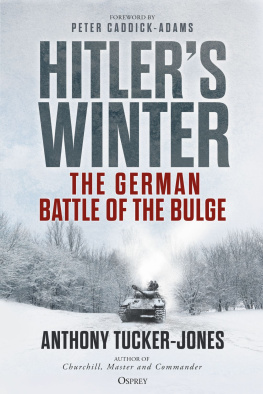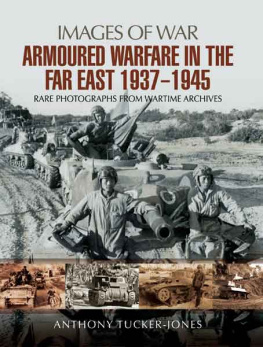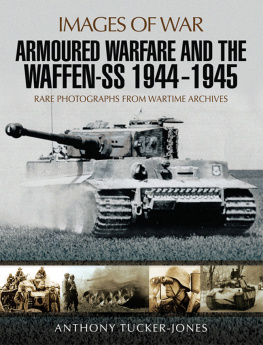Chapter One
Bourgubus Ridge
F ollowing the D-Day landings on 6 June 1944 , American forces fought to secure the port of Cherbourg while the British and Canadian armies battled to take the Norman capital Caen. Operation Goodwood, launched at 0745 on 18 July, the Norman capital Caen. Operation Goodwood, launched at 0745 on 18 July, employing the British 7th, 11th and Guards armoured divisions, was intended to seize the strategic high ground south of the city held by three panzer divisions. In their path lay a series of stone-built villages amidst hedge-lined fields and orchards. The Bourgubus Ridge was to prove a bloody tank graveyard.
General von Obstfelders 86th Corps was supported by the 21st and 1st SS Panzer Divisions, while the 12th SS at Lisieux constituted the 1st SS Panzer Corps reserve. In addition Tigers of the 503 and 101 SS Heavy Panzer Battalions were also available. The 1st SS were in reserve at Falaise, way to the south of Caen when Goodwood was launched, between Eterville and Mondeville, and were directed eastward towards Cagny. Subsequently the 1st SS and 12th SS were redeployed to the south and east of Caen on a line from Bras-Bourgubus-Frnouville-Emiville, while 21st Panzer lay between Emiville and Troarn along with the Tiger tanks.
The British assessed the German defences to be to a depth of three miles, when in fact generals Rommel and Eberbach had built five defensive zones covering ten miles.The first consisted of the infantry, then sixty tanks from 21st Panzer and thirty-nine Tigers; a chain of fortified villages and then the artillery on a gun line including the Garcelles-Secqueville woods and the Bourgubus Ridge, supported by panzergrenadiers and Panther tanks from the 1st SS. The final zone comprised two kampfgruppen from the 12th SS.
British intelligence severely underestimated the German defences, which were supported by 230 panzers, although including other armoured fighting vehicles this force totalled nearly 400. The initial defences, comprising the 16th Luftwaffe Field Division and 21 st Panzers inadequate assault gun battalion, were unlikely to hold up the British tanks for any length of time, especially once they had been pulverized by the Allied bomber fleets. Therefore the German defence relied on the panzergrenadiers of Kampfgruppe von Luck, drawn from the 21st Panzer.
The powerful German gun line on the Bourgubus ridge included seventy-eight 88mm guns, 194 field guns, twelve heavy flak guns and 272 nebelwerfer rocket launchers, though in reality much of this equipment was spread throughout the German defensive zones.The best defensive weapons in the Main Line of Resistance were just seventeen Pak 43s, the dedicated tank killer version of the 88mm flak gun, belonging to Panzerjger Battalion 200. Just eight 88mm flak guns from Flak Battalion 305 supplemented these.
Divisional artillery was a hotchpotch of captured French and Russian guns deployed on the reverse slopes of the Bourgubus Ridge. Most of the 88mm anti-aircraft guns belonged the 3rd Flak Corps, which was under strict orders from Panzergruppe West to defend the Caen-Falaise road from air attack. Most of the guns were therefore to the south and east of Bourgubus with air defence a priority.
Panzer Mk IVs of Panzer Regiment 22 (belonging to 21st Panzer), along with the Tiger tanks, were caught in the Allied saturation bombing near Chteau de Manneville sixteen miles east of Caen. The effects were devastating, with tanks tossed upside-down like toys. From a force of about fifty panzers over half were lost; many others suffered mechanical problems.
The 16th Luftwaffe Field Division was incapable of withstanding the bombardment and encroaching enemy tanks, and in reality was little more than a sacrificial lamb.The 21sts Panzergrenadier Regiment 192 was at risk of being overrun and 1st Battalion Panzergrenadier Regiment 125 was cut off at le Mensil Frmental, to the east, though 2nd Battalion was holding on at Emiville and Guillerville.
The village of le Mesnil-Fremental lay right in the middle of the British line of attack. The 21 st Panzer Divisions five batteries from its assault gun battalion were deployed at Dmouville, Giberville, Gentheville and the farms of le Mensil-Frmental and le Prieur, supported by von Lucks panzergrenadiers. On the eastern half of the battlefield they represented the Germans only mobile tactical reserve.
These forces attempted to hold up the British advance, but the guns at Cuverville and Dmouville were lost in the opening bombardment and the battery at Giberville withdrew northwest of Bras and, along with those at Grentheville, shelled British tanks to the east and west. The two batteries at the farms, lacking infantry protection, were also soon forced back by the relentless tide of enemy tanks. The assault gun battalion engaged the British 29th Brigades lead regiment, the Fife and Forfar Yeomanry, destroying more than twenty Shermans before conducting a fighting withdrawal towards the 1st SS stop line on Bourgubus ridge.
The British armour had 3,000 yards of open ground to cover before they reached the ridge marked by the villages of Bras, Hubert Folie and Bourgbus itself, all of which were tough German strongpoints. They got to within a few hundred yards before the Germans opened fire, knocking out four tanks in quick succession, followed by at least another seven to their right. A Squadron of the 3rd Battalion Royal Tank Regiment swiftly lost thirty-four of its fifty-two tanks.
Just after 0930, determined to hold Cagny and the vital Bourgubus, the Germans threw the 21st Panzer and 503 Heavy Panzer Battalion at the Guards and 11th Armoured Divisions with orders to regain the Caen-Troarn road. About forty-six panzers of 1st Battalion, SS Panzer Regiment 1, were thrown into action against the British in the area of the Bourgubus at 1620.Taking up positions on the Bourgubus Ridge the division inflicted heavy casualties on the British 7th and 11th Armoured Divisions, who received a very nasty surprise with the appearance of the 1st SS.
The Panthers of the 1st SS also rolled down from Bourgubus Ridge, driving back the British. In the process of trying to force them back to Caen-Troarn the two panzer divisions lost 109 tanks, while by the end of the first day the British had suffered 1,500 casualties and 200 tanks destroyed for the gain of just six miles beyond the Orne. However, the north-south line from Frnouville to Emiville held and, with the commitment of the 1st SS Goodwood, came to a grinding halt over the next few bloody days.
Exhausted by the fighting, the panzers of 1st SS wanted to break off combat on the Bourgubus Ridge, but their request was denied due to the activity of Allied fighter-bombers; presumably on the grounds that if they stayed in close proximity to the British they were at less risk of air attack. Although German losses were high they achieved the desired effect and the 11th Armoured Division lost 106 of its tanks. West of Cagny the Guards Armoured Division was also held up, having lost sixty tanks.
Now that the Bourgubus Ridge was such a bloody killing ground, when the panzergrenadiers from 1st SS moved up on the night of 18/19 July they must have been fearful that the Allied bombers would repeat the previous days attack. The British brought up artillery on the 19th to cover the advancing tanks, but the Northants Yeomanry veered towards Ifs to the west of Bras and were driven back toward Caen. At Bras the 1st SS defenders were not so lucky and were ejected at 1900 with the loss of a dozen self-propelled guns and many dead. By 1740 the entire 3rd Battalion, SS Panzergrenadier Regiment 1, had been destroyed in and around Bras.
Heavy rain and the actions of the 1st SS and 21st Panzer Divisions brought Goodwood to a halt on 20 July. In just two days the British 2nd Army had lost 413 tanks - some thirty-six per cent of its total tank strength. The 1st SS, 12th SS and 21st Panzer had effectively hemmed in Goodwood.

















